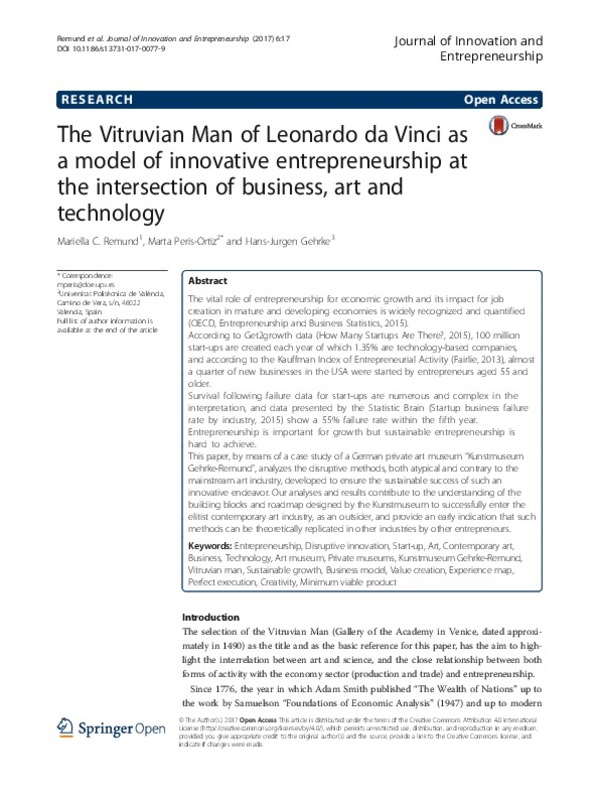Birkett, W. B. (2012). To infinity and beyond: A critique of the aesthetic white cube, Theses. Paper (Vol. 209).
Bußmann, H. G. (2015). Die eigene Kunstsammlung: Uber Motive und Sammlertypen. http://www.kunstmarkt.com/pagesprz/kunst/_d345070-/show_praesenz.html . Accessed 29 Jan. 2017.
Campbell, S. (2016), Leonardo Da Vinci’s Life. http://www.davincilife.com/vitruvianman.html . Accessed 29 Jan 2017.
[+]
Birkett, W. B. (2012). To infinity and beyond: A critique of the aesthetic white cube, Theses. Paper (Vol. 209).
Bußmann, H. G. (2015). Die eigene Kunstsammlung: Uber Motive und Sammlertypen. http://www.kunstmarkt.com/pagesprz/kunst/_d345070-/show_praesenz.html . Accessed 29 Jan. 2017.
Campbell, S. (2016), Leonardo Da Vinci’s Life. http://www.davincilife.com/vitruvianman.html . Accessed 29 Jan 2017.
Child, J. (1972). Organization structure, environment and performance: The role of strategic choice. Sociology, 6, 1–22.
Child, J. (1997). Strategic choice in the analysis of action, structure, organizations and environment. Organization Studies, 18, 43–76.
D’Angelo, M. and Schlenker, K. (2015), Is there a bubble in the art market? http://www.huffingtonpost.com/Madelaine-dangelo/is-there-a-bubble-in-the_b_8630434.html . Accessed 29 Jan 2017.
Fairlie, R. W. (2013). Kauffman Index of Entrepreneurial Activity. http://www.kauffman.org/~/media/kauffman_org/research%20reports%20and%20covers/2013/04/kiea_2013_report.pdf . Accessed 29 Jan 2017.
Get2growth (2015), How many startups are there? http://get2growth.com/how-many-startups/ . Accessed 29 Jan 2017.
Gleason, M. (2010). Mexico en Alemania y Austria. Mexico City: Educal.
Gleason, M. (2014). Mexico insólito en Europa. Mexico City: Fogra Editorial de Mexico.
Hayton, J. C. (2005). Promoting corporate entrepreneurship through human resource management practices: a review of empirical research. Human Resource Management Review, 15, 21–41.
Hayton, J. C. (2006). A competency-based framework for promoting corporate entrepreneurship. Human Resource Management, 45(3), 407–427.
Martin, C. J. (2016). The sharing economy: a pathway to sustainability or a nightmarish form of neoliberal capitalism? Ecological Economics, 121, 135–153.
Meier-Grolman, B. (2016). “Zehn Jahren Museum Frieder Burda in Baden-Baden”, Südwest Presse Online. http://www.swp.de/ulm/nachrichten/kultur/Zehn-Jahren-Museum-Frieder-Burda-in-Baden-Baden;art4308,2701048 . Accessed 29 Jan 2017.
Mensch, C. (2015). “Schwarze Kunst und Rote Zahlen”. Schweiz am Sonntag. http://www.schweizamsonntag.ch/ressort/basel/schwarze_kunst_und_rote_zahlen/ . Accessed 29 Jan 2017.
Mont, O. (2004). Institutionalisation of sustainable consumption patterns based on shared use. Ecological Economics, 50, 135–153.
OECD (2015). Entrepreneurship and business statistics. http://www.oecd.org/std/business-stats/ . Accessed 29 Jan 2017.
Penrose, E. (1959). The theory of the growth of the firm. Oxford, Basil Blackwell and New York: John Wiley & Sons.
Raue, P. (2010). “Sammeln wir die falsche Kunst?”. Zeit Online. http://www.zeit.de/2010/03/Kunstmarkt . Accessed 29 Jan 2017.
Remund, M.C. (2013). “Largest exhibition of the life and art of Frida Kahlo makes U.S. premiere in San Diego”. Business Wire. http://www.businesswire.com/news/home/20131007006586/en/Largest-Exhibition-Life-Art-Frida-Kahlo-U.S . Accessed 29 Jan 2017.
Samuelson, P. A. (1947). Foundation of Economic Analysis. Cambridge: Harvard University Press.
Saya, A. (2015). “Mehr Aufbruchs-Als Krisenstimmung”. Stuttgarter Zeitung. http://www.stuttgarter-zeitung.de/inhalt.symposium-grenzen-des-wachstums-mehr-aufbruchs-als-krisenstimmung.76a6553e-54be-4ba4-823d-9710e6b746b3.html . Accessed 29 Jan 2017.
Schumpeter, J. A. (1934). The theory of economic development. Cambridge: Harvard University Press.
Schumpeter, J. A. (1950). Capitalism, socialism and democracy (3rd ed.). New York: Harper & Row.
Shane, S., & Venkataraman, S. (2000). The promise of entrepreneurship as a field of research. Academy of Management Review, 25, 217–226.
Statistic Brain (2015). Startup business failure rate by industry. http://www.statisticbrain.com/startup-failure-by-industry/ . Accessed 29 Jan 2017.
Sutton, B. (2016). “Crunching the numbers behind the boom in private art museums”. Hyper allergic, http://hyperallergic.com/269548/crunching-the-numbers-behind-the-boom-in-private-art-museums/ . Accessed 29 Jan 2017.
Tracey, P., Phillips, N., & Jarvis, O. (2011). Bringing institutional entrepreneurship and the creation of new organizational forms: a multilevel model. Organization Science, 22(1), 60–80.
Voss, J. (2015). “Vielleicht gibt es einfach zu viele Museen. Frankfurter Allgemeine Zeitung. http://www.faz.net/aktuell/feuilleton/kunst/ein-gespraech-mit-christiane-lange-13844184.html . Accessed 29 Jan 2017.
Weick, K. E. (1969). The social psychology of organization. Reading: Addison Wesley.
[-]









